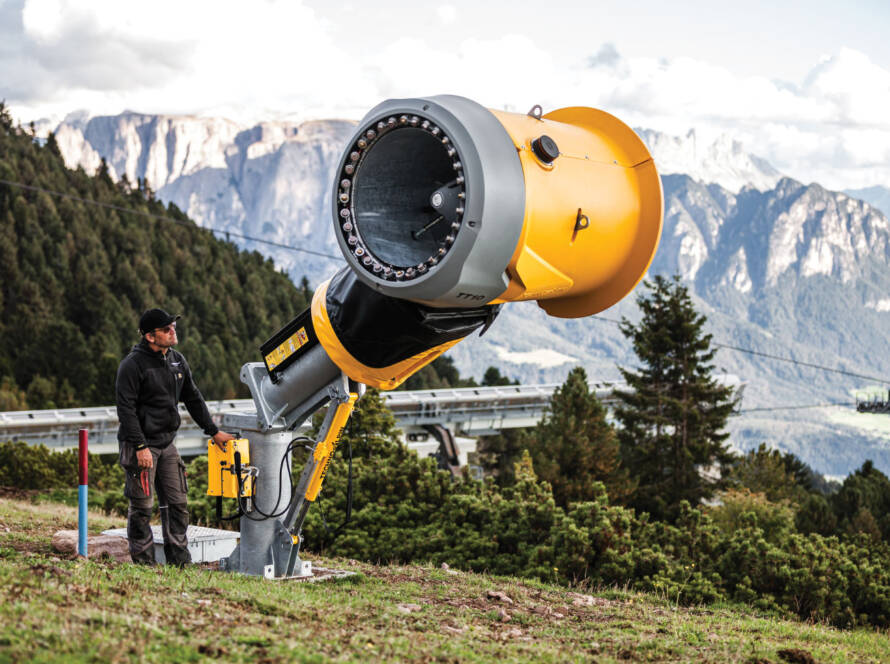It’s not easy to build on a mountainside. Challenges can include extreme slope angle, altitude, rock ledges, soil inconsistency, high winds and extreme weather. Traditional approaches include excavating, pouring concrete piles or foundations, moving materials to and from the site, and meeting deadlines.
From chairlift towers and light poles to snowmaking platforms and building foundations, the ski industry has seen very few innovations and changes in installation methodology over the decades. Thus, challenges and horror stories tend to follow the same patterns and sequences.
With capital constraints and sustainability as priorities, the question arises: How can ski resorts and areas save money on infrastructure projects? One method is to change the “how it’s done” methodology and open up to new and innovative approaches.
Introducing the helical pile foundation as a less expensive, easier, safer and faster track for anything “foundational.” Simply put, a helical pile is a large screw that is specifically designed for a particular application. It literally screws into the ground, acting as an anchor. Such piles are not new and have been used to build anything from bridges to skyscrapers, all without pouring concrete.
The advantages of helical piles include:
- Fast installation – no need to wait for concrete to cure.
- Easy handling – no challenges moving and pouring concrete on a slope.
- No curing variables – unaffected by weather or temperature.
- Strong and reliable.
- Easy to remove and reusable – can be unscrewed.
- Versatile – can be used for chair lift towers, light poles, barriers and building foundations.
- No cement trucks or pouring from a helicopter.
- No concrete spalling.
- Economical installation.
Steamboat Springs case study
Helical piles were used for lighting installation at Steamboat Springs Ski Resort in Steamboat, Colo. This was a large project encompassing black diamond expert slopes, intermediate terrain, a freestyle park and beginner area. In planning the project, the first inclination was to pour concrete piles to support the 30-foot light poles. As it turned out, some areas were too steep to accommodate a cement truck, leaving a helicopter as the only alternative. Cost and scheduling would be a nightmare.
Coincidentally, Steamboat’s vice president of operations, Doug Allen, was familiar with helical piles. The Steamboat project was on a tight schedule and all involved were concerned about cost and timing. As it turned out, using helical piles was the correct approach.
In fact, almost 200 poles were mounted in under three weeks without a glitch. The cost was substantially less than excavating and pouring concrete. Although the crew did not intend to move poles, the resort teamed up with the local ski club and designed a new private slope for race training and events called “All Out.” This project called for moving some of the lighting, which was easily done.
Durable and safe
There are many reasons why helical piles provide a better solution than concrete. For structures likely to experience lateral loading from forces such as wind, snow or gravity from slope angle, concrete foundations can fail along the perpendicular force line. In addition, the dynamic vertical weight bearing experienced on chairlifts requires compression capacity. Helical piles address both engineering challenges.
When installing in certain soils or rock ledges, consideration should be given to the settle point where the screw reaches its end. It is difficult to know the final angle of the mounting structure; i.e. where it will be positioned. At Steamboat, the crew created a slotted mounting plate for the poles, which allowed rotation to orient the mounting brackets at the right angle to the slope. This design added a small and justifiable cost to the otherwise generic pole.
At some locations, new chairlifts are being installed and others are being moved. Had helical piles been used during the original installation, major problems now could have been avoided. Most notably: How to deal with the old concrete piles? Removal is difficult and expensive. Leaving the piles can be unsightly and may not conform to remediation requirements in forest and parkland areas. As mentioned, helical piles can simply be unscrewed.
Worried about frost heaving? Some helical piles are available with heavy-duty polyethylene sleeves that guard against ground movement. Almost any loading condition can be accommodated by varying pile materials, diameter and depth. This is particularly important in high altitude locations where permafrost conditions can exist and there is concern about potential thawing and/or heaving.
Having mentioned speedy installation, consider that helical piles can be in place with just a few full rotations. A helical pile can be in the ground and ready for loading in less than a minute; try that with concrete! Load testing can be immediate upon installation; no waiting days, weeks or even more than a month as with traditional concrete piles. As they say, “Time is money.”
Indeed, excavation isn’t only time consuming and expensive, it’s messy. Helical piles use less equipment, are neat and well organized at the job site, and there is no clean-up; they are a clean install.
It’s also important to note that concrete curing emits large amounts of carbon dioxide; 900 kilograms of CO2 are emitted for every ton of cement fabricated. Helical piles are more environmentally friendly because metal fabrication emits only a fraction of this amount for the same utility.
To be sure, helical piles may not be right for every project. The point is that their implementation should be considered for infrastructure projects to see the potential cost savings, and have a more flexible and durable end result. There are many sources for helical piles, also known as “screw piles” or “H-piles.” A simple internet search should give all the resources needed for an upcoming project. If it happens to be a new chairlift or building, make sure to ask if helical piles can be used instead of concrete.

![[image placeholder]](https://www.snowopsmag.com/wp-content/uploads/2023/09/placeholder@2x-890x664.png)